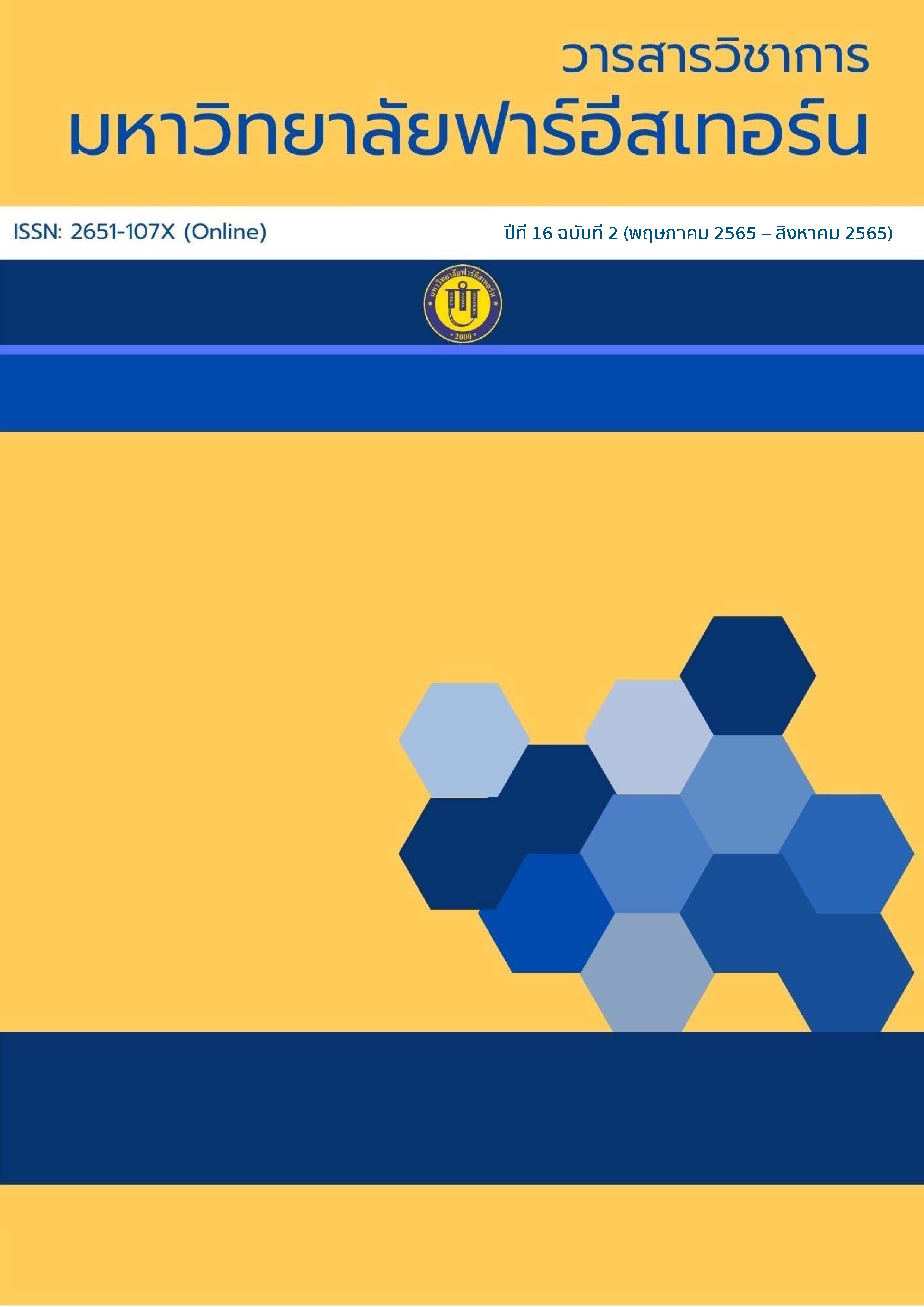Development of Media for Creative Military Tourism for Elders and Tourists with Disabilities: A case study of Northern Petroleum Development Center
Main Article Content
Abstract
This research is a mix of qualitative and quantitative approach. Its objectives are 1) to study behavior in perceiving media for tourists who are disables and elderlies in military area attraction, 2) to develop and produce promotion media suitable for creative tourism for tourists who are disables and elderlies in military area attraction, including evaluation of experience and satisfaction in using promotion media supporting disables and elderlies in in military area attraction. For quantitative analysis, samples include 1) 150 persons with motion disabilities and 2) 150 elderlies who are Baby Boomers, and questionnaire is a tool for data collection, from which techniques used are data percentage, frequency, average, MANOVA with research methods such as population, sampling, sample selection, statistical data analysis, research and validation tools. For qualitative analysis, group discussion for promotion media development participatorily that is suitable and supportive for the need of disables and elderlies. Participants include a total of 25 tourists including 13 disable and elderly, five military officers at museum and learning center for petroleum of power, two researchers, and five physical therapists, to participate in a participatory promotion media development suitable and supportive for the need of disables and elderlies. The study finds that medias that have the most influence in decision making and suggesting the attraction including media used in finding information about the attraction of the study samples i.e., disables and elderlies are social media (e.g., Facebook, Line, and reviews) and the Internet (e.g., tourism websites). The least influential medias are radio and newspapers. In addition, the study also finds that the contents that each group of the participants value are different. Elderlies value the content about the accommodation, while the tourists with motion disabilities value the content about facilities (such as handicap restrooms, wheelchairs, nearby hospitals for instance). The qualitative analysis of the participants enables the development of promotion medias that are suitable for both target groups, which are brochure and short clip. A short clip is found to help stimulate the desire to travel more than the brochure.
Article Details

This work is licensed under a Creative Commons Attribution-NonCommercial-NoDerivatives 4.0 International License.
1. Any views and comments in the Journal of Social Innovation and Lifelong Learning are the authors’ views. The editorial staff have not to agree with those views and it is not considered as the editorial’s responsibility.
2. The responsibility of content and draft check of each article belongs to each author. In case, there is any lawsuit about copyright infringement. It is considered as the authors’ sole responsibility.
3. The article copyright belonging to the authors and The Far Eastern University are copyrighted legally. Republication must be received direct permission from the authors and The Far Eastern University in written form.
References
กรมการปกครอง. (2560, 20 เมษายน). จำนวนประชากรแยกรายอายุ. https://stat.bora.dopa.go.th/new_stat/webPage/statByProvince.php?year=60
กรมกิจการผู้สูงอายุ. (2562, 20 เมษายน). สถานการณ์ผู้สูงอายุไทย ปี 2562. http://www.dop.go.th/download/knowledge/th1552463947-147_0.pdf
กรมส่งเสริมและพัฒนาคุณภาพชีวิตคนพิการ. (2562, 25 เมษายน). สถานการณ์คนพิการ 31 มีนาคม 2562. https://dep.go.th/images/uploads/Downloads/pdf/20190401.pdf
ไพศาล กาญจนวงศ์. (2552). หลักการประชาสัมพันธ์. สื่อการสอนวิชานิเทศศาสตร์เพื่อการท่องเที่ยว. http://lms.mju.ac.th/courses/631/locker/content/%E0%B8%9E%E0%B8%97%20335/td335/chapter3/chapter3_1.htm
เลิศพร ภาระสกุล. (2555). พฤติกรรมนักท่องเที่ยว. สำนักพิมพ์แห่งจุฬามหาวิทยาลัย.
สุวีร์ณัสญ์ โสภณศิริ. (2554). การวิเคราะห์พฤติกรรมนักท่องเที่ยว. สำนักพิมพ์อินทนิล.
องค์การบริหารการพัฒนาพื้นที่พิเศษเพื่อการท่องเที่ยวอย่างยั่งยืน. (2561, 15 สิงหาคม). CREATIVE TOURISM การท่องเที่ยวเชิงสร้างสรรค์. http://creativetourism.circlecamp.com/index. php?page=aboutus
Adeyanju, A. (2015). Comparative Study of Social Media, Television and Newspapers' News Credibility. Proceedings of the International Conference on Communication, Media, Technology and Design (pp. 69-77). Dubai, United Arab Emirates.
Andereck, K. L. (2005). Evaluation of a Tourist Brochure. Journal of Travel & Tourism Marketing, 18(2), 1-13. https://doi.org/10.1300/J073v18n02_01
Burnett, J. J., & Baker, H. B. (2001). Assessing the Travel-Related Behaviors of the Mobility-Disabled Consumer. Journal of Travel Research, 40(1). 4–11. https://doi.ort/10.1177/004728750104000102
Darcy, S. (2010). Inherent complexity: Disability, accessible tourism and accommodation information preferences. Tourism Management, 31(6), 816-826. http://doi.ort/10.1016/j.tourman.2009.08.010
Edewor, N., Ijiekhuamhen, O., & Emeka-ukwu, U. (2016). Elderly People and Their Information Needs. Library Philosophy and Practice (e-journal). 1332. http://digitalcommons. unl.edu/libphilprac/1332
European Network for Accessible Tourism. (2007, December). Service and facilities for accessible tourism in Europe. https://www.accessibletourism.org/resources/enat_study-2_services_and_facilities_en.pdf
Fotis, J., Buhalis, D. & Rossides, N. (2012). Social Media Use and Impact during the Holiday Travel Planning Process. Proceedings of the Information and Communication Technologies in Tourism 2012 (pp. 13-24). Helsingborg, Sweden. http://dx.doi.org/10.1007/978-3-7091-1142-0_2
Fox, L. (2015, December 1). How video influences travel decisions. https://www.phocuswire. com/How-video-influences-travel-decisions
Icoz, O., Kutuk, A, & Icoz, O. (2018). Social media and consumer buying decisions in tourism: The case of Turkey. PASOS. Revista de Turismos y Patrimonio Cultural, 16(4), 1051-1066. http://dx.doi.org/10.25145/j.pasos.2018.16.073
Patterson, I. (2007). Information sources used by older adults for decision making about tourist and travel destinations. International Journal of Consumer Studies - Int J Consum Stud., 31(5), 528-533. https://doi.org/10.1111/j.1470-6431.2007.00609.x
Ribeiro, F. R., Silva, A., Barbosa, F., Silva, A. P., & Metrôlho, J. C. (2018). Mobile applications for accessible tourism: overview, challenges and a proposed platform. Information Technology & Tourism, 19(1), 29-59.
Swarbrooke, J. & Horner, S. (2007). Consumer Behavior in Tourism (2nd ed.). Burlington, MA: Elsevier.
World Tourism Organization. (2016). UNWTO recommendations on accessible information in tourism. https://webunwto.s3-eu-west-1.amazonaws.com/2019-08/recommendationsaccesstourismforallenok.pdf
World Tourism Organization (UNWTO) and European Travel Commission (ETC). (2018). Exploring Health Tourism – Executive Summary, UNWTO, Madrid. https://www.eunwto.org/doi/epdf/10.18111/9789284420308, 08.11.2020.
Zhou, Zongqing. (1997). Destination Marketing: Measuring the Effectiveness of Brochures. Journal of Travel & Tourism Marketing. 6(3-4). 143-158. https://doi.org/10.1300/J073v06n03_09

